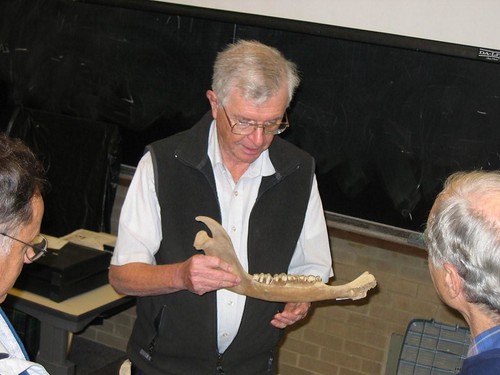
Holmes A. Semken
1935-present
Semken was born in Knoxville, Tennessee and spent much of his childhood living in Maryville, Tennessee and Hot Springs Arkansas. When in high school his family moved to Rockdale, Texas where he graduated from Rockdale High School. The summer after graduation Semken participated in an archaeological field trip which led to him being offered a job at the Texas Memorial Museum in Austin, and at the museum Semken performed a variety of occupations from serving as a night guard, to traveling to New Mexico to collect bison bones sparking an interest in vertebrate osteology and paleontology.
In 1958, Semken graduated from the University of Texas-Austin with a bachelor of science degree in geology, after which he entered the graduate program at Texas, and completed his MA degree in geology in 1960. From 1961 to 1962, Semken worked for the Smithsonian at a site outside of Littleton, Colorado where parts of 21 Columbian mammoths (Mammuthus columbi) were uncovered.
Following his graduation from Austin, Semken entered the geology Ph.D program at the University of Michigan, Ann Arbor and graduated in 1965. His dissertation was titled: Stratigraphy and paleontology of the McPherson equus beds (Sandahl local fauna), McPherson County, Kansas. Following completion of his Ph.D, Semken was hired as an assistant professor at the University of Iowa in 1965, he was promoted to associate professor in 1969, and professor in 1973. He served as chair of the University of Iowa department of geology from 1986-1992. As of 1999, Semken is an emeritus professor at the University of Iowa.
Semken's professional memberships include being a fellow of
both
the Geological Society of America and the Iowa academy of Science, a member of
the
Paleontological Society, Society of Vertebrate Paleontology, American Society of Mammalogists,
International Union for Quaternary Research, American Quaternary Association,
and the American Geological Institute. He is also a member of the Plains
Anthropological Society, Society American of Archaeologists, and National
Speleological Society. Throughout his career Semken has received several
awards and recognitions. These include memberships in the honors societies
Sigma Xi and Sigma Gamma Epsilon, inclusion in Who's Who, American Men &
Women of Science,
delegate to the
During his graduate work and research at the University of Iowa, Semken's research interests focused on the taphonomy and zooarchaeology of micromammals but also include the larger topics of paleoecology, biogeography, and evolution. His research has also examined the extinction of Pleistocene vertebrates and Holocene vertebrate biogeography. Much of Semken's work has focused on the Wisconsin-Holocene extinction event and micromammals in the Holocene in the Northern Great Plains. Throughout his career Semken has conducted field research throughout Iowa, Missouri, Texas, and Arkansas while focusing on the Pleistocene in the early part of his career, then shifting his focus to the Holocene. As a professor at the University of Iowa, Semken has mentored over 35 students, published over 50 papers-not including site reports, and authored several book reviews.
Currently Semken serves on the Iowa Office of the State Archaeologist advisory committee and is a co-principle investigator on the NSF funded Tarkio Valley sloth project.
"This could be our 'Rosetta Stone' for understanding the family life of these mysterious creatures." Quote from Holmes Semken regarding the Tarkio Valley sloth find.

Holmes Semken's page at the University of Iowa may be found through: http://www.uiowa.edu/~geology/people/holmes.html
Click here for more information on the Tarkio Valley sloth project: http://slothcentral.com/